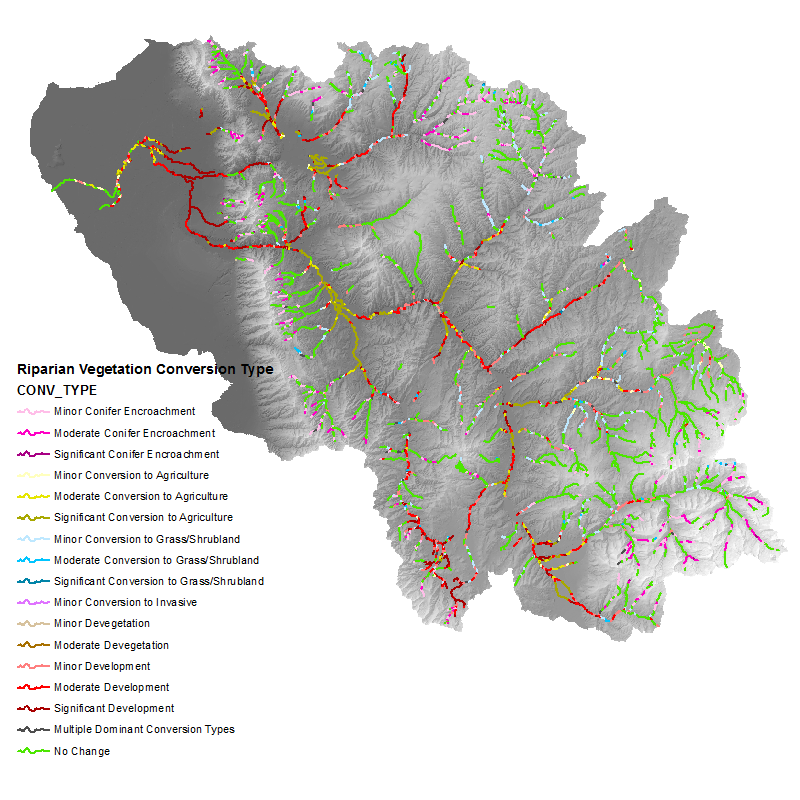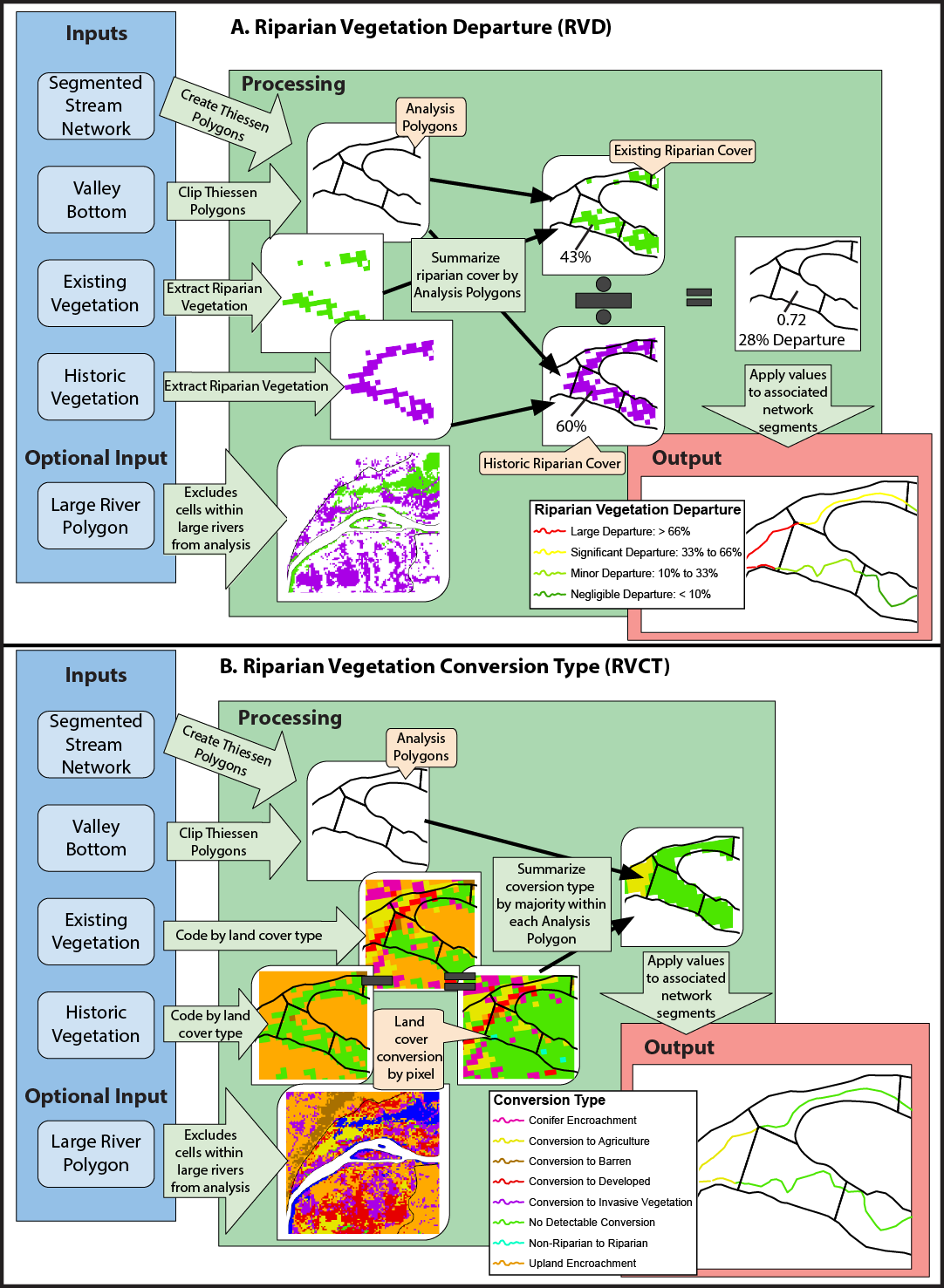Wiki
Clone wikiRiparian Condition Assessment Tools / Tool_Documentation / Version_1.0 / RVD
Riparian Vegetation Departure (RVD)
The Riparian Vegetation Departure (RVD) tool uses LANDFIRE landcover inputs to determine the departure of riparian vegetation from pre-settlement conditions. Current riparian vegetation cover is modeled using the LANDFIRE Existing Vegetation Type (EVT) layer. Historic (pre-European settlement) vegetation is modeled using the LANDFIRE Bio-physical Setting (BpS) layer. For more information on these layers see LANDFIRE's website. In both of these layers, all native, riparian vegetation is given a value of 1, and all other vegetation is given a value of 0. The valley bottom is broken into polygons that correspond to approximately 500 meter segments of stream network, and within each polygon, the number of existing riparian cells is divided by the number of modeled historic riparian cells. The result is a ratio that represents the proportion of historic riparian vegetation that currently exists on the landscape. This value is then applied to the network. In addition, an analysis is performed that looks at types of riparian conversion and quantifies each type within each stream segment to determine possible causes of riparian degradation.
Pre-Processing
- Prepare a network using the NHD Network Builder
- Dissolve and segment the network. (~500 meter segments work well.)
- Produce a valley bottom using VBET, and manually edit to desired accuracy.
- Download the LANDFIRE EVT and BpS layers from the LANDFIRE website
Once the inputs are prepared, you should organize them into a project structure by running the Build RVD Project tool in the toolbox. You will be prompted to select a "project folder," which is a location to store all inputs, outputs and metadata related to the RVD project. You may then select the inputs you plan to use. You may select multiple of any input. For example, you may wish to compare RVD outputs from different years of EVT data. Multiple EVT datasets could be added to the project at this point. Later, when running the RVD tool, you can run the tool multiple times selecting different input datasets. At least one of each required input must be added to the project using this tool. Important: when setting up the project, there cannot be any spaces in any path names. Make sure underscores are used instead of spaces.
RVD Parameters
- Project Name (optional): you may name the project. This will be recorded in the metadata xml.
- Watershed HUC ID (optional): you may add the USGS Hydrologic Unit Code if you are using these watershed boundaries. This will be recorded in the metadata xml.
- Watershed Name (optional): you may add the name of the project watershed. If you are using Hydrologic Unit Codes, this should be the HUC Name that corresponds to the HUC ID. This will be recorded in the metadata xml.
- Select Project Folder: select the project folder that was populated using the Build RVD Project tool.
- Existing Vegetation layer: select the LANDFIRE EVT layer for the area of interest from within the project folder.
- Historic Vegetation layer: select the LANDFIRE BPS layer for the area of interest from within the project folder.
- Input Segmented Stream Network: select the stream network that was dissolved and segmented from within the project folder.
- Input Valley Bottom Polygon: select the valley bottom polygon from within the project folder.
- Large River Polygon (optional): in areas with large rivers (ie Green, Colorado, Snake, Columbia), all landcover cells within these large river polygons are coded as no data. In smaller rivers, the open water landcover class is coded as riparian. In development, we found that coding open water in large rivers as riparian skewed them to appear to be in better condition than they are. In small rivers, if open water was not coded as riparian, they appeared to be in worse condition than they were. The "Area" shapefile that was downloaded with NHD data can generally be used as this large river polygon. If a large river polygon was added to the project, folder, select it.
- Name RVD Output: choose a name for the RVD output (which will be stored in the Analyses in the project file).
- Scratch Workspace: select a geodatabase as a workspace to store temporary files. The default is the Arc default geodatabase.
After the tool has been run, it can be rerun using any combination of input data from within the project. Each subsequent output will be stored in a new folder.
Outputs
- Riparian Vegetation Departure ratio
DEP_RATIO

- Riparian Vegetation Conversion Type
CONV_TYPE

Additional RCA Output Fields
EVT_MEAN: proportion of polygon corresponding to stream segment with existing riparian cover.
BPS_MEAN: proportion of polygon corresponding to stream segment with historic riparian cover.
COUNT: the number of cells within the polygon corresponding to stream segment that were historically riparian.
sum_noch: the number of cells within the polygon corresponding to stream segment whose conversion type is 'no change.'
sum_grsh: the number of cells within the polygon corresponding to stream segment whose conversion type is 'conversion to grass/shrubland.'
sum_deveg: the number of cells within the polygon corresponding to stream segment whose coversion type is 'devegetate.'
sum_con: the number of cells within the polygon corresponding to stream segment whose conversion type is 'conifer encroachment.'
sum_inv: the number of cells within the polygon corresponding to stream segment whose conversion type is 'coversion to invasive.'
sum_dev: the number of cells within the polygon corresponding to stream segment whose conversion type is 'developed.'
sum_ag: the number of cells within the polygon corresponding to stream segment whose conversion type is 'conversion to agriculture.'
prop_noch: proportion of polygon corresponding to stream segment where riparian remained riparian (sum_noch/COUNT).
prop_grsh: proportion of polygon corresponding to stream segment in which riparian was converted to grassland or shrubland(sum_grsh/COUNT).
prop_deveg: proportion of polygon corresponding to stream segment in which riparian was removed and no vegetation took it's place (ie remained dirt or rock) (sum_deveg/COUNT).
prop_con: proportion of polygon corresponding to stream segment in which riparian was converted to conifer forest (sum_con/COUNT).
prop_inv: proportion of polygon corresponding to stream segment in which riparian was converted to invasive vegetation (sum_inv/COUNT).
prop_dev: proportion of polygon corresponding to stream segment in which riparian was converted to developed areas (sum_dev/COUNT).
prop_ag: proportion of polygon corresponding to stream segment in which riparian was converted to agriculture (sum_ag/COUNT).

Conceptual diagram showing how vegetation departure from historic and riparian vegetation conversion type are calculated
Updated